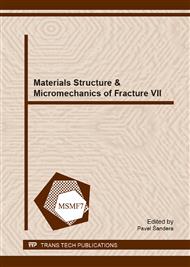p.672
p.676
p.680
p.684
p.688
p.692
p.696
p.700
p.704
Microstructure and Defects Evaluation of Varistors by Ultrasonic Waves in Low Frequency Range
Abstract:
Each material contains defects and in-homogeneities in a structure volume. It has influence on the properties of material (conductivity, mass density, mechanical properties). Interaction of the ultrasonic waves with defects or in-homogeneities in the solid state is not clear. Electro-ultrasonic spectroscopy can help to clarify this phenomenon. The electro-ultrasonic spectroscopy describes defects and un-homogeneities inside the sample structure. This method is quite different from electro-acoustic effect. Ultrasonic signal is in range from 20 kHz to 150 kHz. Ultrasonic signal changes geometry of the sample in elastic range only. The sizes of cracks are changing also in the sample volume. Conductivity near the area of cracks is strongly changing due to ultrasonic vibrations. It has influence on resistance of the sample which is changing along with a frequency of ultrasonic vibrations. The amplitude of the resistance change depends on the material, number of cracks, size of cracks and Eigen frequencies of the sample excited by ultrasonic wave. We applied the electro-ultrasonic spectroscopy on two types of varistors. It can be useful for understanding the relation between microstructure and mechanical properties of these types of varistors.
Info:
Periodical:
Pages:
688-691
Citation:
Online since:
November 2013
Authors:
Price:
Сopyright:
© 2014 Trans Tech Publications Ltd. All Rights Reserved
Share:
Citation:


